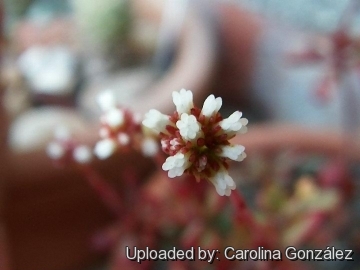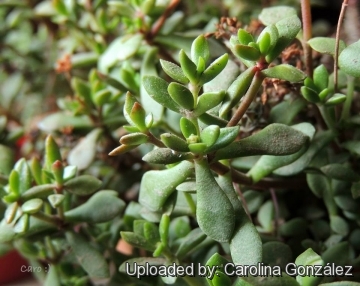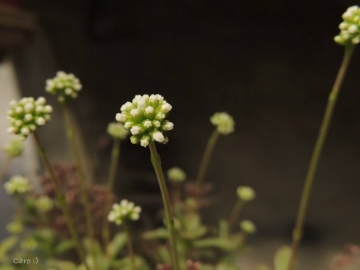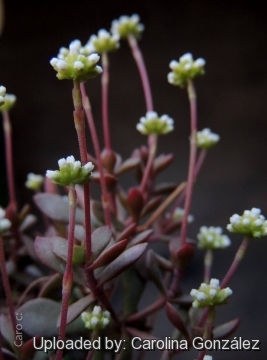Accepted Scientific Name: Crassula pubescens subs. radicans (Haw.) Toelken
J. S. African Bot. 41: 115 1975

Globulea radicans (Crassula pubescens subs. radicans) Photo by: Carolina González
Origin and Habitat: Cape Province, South Africa. This plant has been found naturalized in Jersey (an island in the English Channel) and occasionally in warm temperate areas around the world.
Habitat and ecology: Crassula pubescensSN|26776]]SN|26776]] subs. radicans usually grows in rocky quartz fields and uses nurse plants to protect against frosts, harsh sun, trampling, etc. so one must look carefully under shrubs and trees to find them.
Synonyms:
See all synonyms of Crassula pubescens
Common Names include:
ENGLISH: Red Carpet
CHINESE (中文): 红稚儿
Description: Crassula pubescensSN|26776]] (also known as Crassula pubescensSN|26776]]SN|26776]] ssp. radicans) is a low growing shrubby or creeping succulents up to 30-40 cm tall, with small emerald green oval leaves that blush deep red in bright light or cold temperatures and give an overall appearance of a succulent leafy carpet. It is similar to Crassula pubescensSN|26776]]SN|26776]] but has glabrous leaves. It becomes mat-forming in time and produces dense clusters of tiny white flowers. Some authors make C. radicans synonymous with Crassula pubescensSN|26776]].
Stem: Suffruticose, prostrate with ascending-erect tips, with spreading lateral branches that take root beneath, laxly leafy.
Leaves: 10-15(-25) mm long, and 6-8 mm wide, paired, united at the base, lanceolate-oblong or lanceolate, narrow, flattish, subacute or acute, mostly glabrous, smooth-edged. The leaves are emerald green and takes on a lovely red glow if grown in full sun.
Inflorescences: Peduncle elongate, slender, with distant leaf-scales, glabrescent, cymoso-corymbose at the summit, the cymules dense.
Flowers: Calyx-lobes linear, white, blunt, pubescent, keeled. Petals connate at base, panduriform, with an oblong, sub-apical dorsal gland. Stigma nearly sessile.
Subspecies, varieties, forms and cultivars of plants belonging to the Crassula pubescens group
 Crassula pubescens Thunb.: (subsp. pubescens) has erect habit without adventitious roots, a rounded inflorescence and petal appendages twice as long as broad, the corolla cream to pale yellow. Distribution: Western Cape.
Crassula pubescens Thunb.: (subsp. pubescens) has erect habit without adventitious roots, a rounded inflorescence and petal appendages twice as long as broad, the corolla cream to pale yellow. Distribution: Western Cape. Crassula pubescens subs. radicans (Haw.) Toelken: has glabrous leaves, delicate decumbent branches and spherical petal appendages. Distribution: Port Elizabeth and King William's Town.
Crassula pubescens subs. radicans (Haw.) Toelken: has glabrous leaves, delicate decumbent branches and spherical petal appendages. Distribution: Port Elizabeth and King William's Town.- Crassula pubescens subs. rattrayi (Schönland & Baker f.) Toelken: Is rosulate with short branches, no adventitious roots, leaves covered with short hairs and inflorescence often elongated. Distribution: Graaff-Reinet to Tarkastad in the Eastern Cape.
Bibliography: Major refernces and further lectures
1) Hermann Jacobsen “Abromeitiella to Euphorbia” Blandford Press, 1960
2) W. H. Harvey “Flora Capensis”, Vol 2, 1894
3) Frederick Gustav Meyer “Plant explorations: ornamentals in the Netherlands, West Germany, and Belgium” Agricultural Research Service, U.S. Dept. of Agriculture, 1963
 Globulea radicans (Crassula pubescens subs. radicans) Photo by: Carolina González
Globulea radicans (Crassula pubescens subs. radicans) Photo by: Carolina González Globulea radicans (Crassula pubescens subs. radicans) Photo by: Carolina González
Globulea radicans (Crassula pubescens subs. radicans) Photo by: Carolina González Globulea radicans (Crassula pubescens subs. radicans) Photo by: Carolina González
Globulea radicans (Crassula pubescens subs. radicans) Photo by: Carolina González Globulea radicans (Crassula pubescens subs. radicans) Photo by: Carolina González
Globulea radicans (Crassula pubescens subs. radicans) Photo by: Carolina GonzálezCultivation and Propagation: Crassula pubescens ssp. radicans is adaptable, not difficult to cultivate, accepting drought with an occasional drink of water for optimal health. It loves heat and is easy to root and propagate. It thrive with bright light and ample airflow. It is grown for its attractive foliage and offer a wide variety of sizes, shapes and colours. It makes a nice groundcover in subtropical and warm temperate climates where it gives an overall appearance of a succulent leafy carpet. The leaves turn red in the sun. Perfect for all kinds of containers. Looks great in rock gardens.
Growth rate: Moderately fast (bordering on invasive!) plant for the garden.
Soil: It grows best in sandy-gritty soil. Good drainage is very important as it is prone to root rot.
Repotting: Repot every two years in spring. Do not radically cut off roots: about 10 percent of the root ball is right.
Fertilization: Feed it from mid spring to early autumn every four or five weeks with a fertilizer specifically formulated for cactus and succulents (poor in nitrogen), including all micro nutrients and trace elements diluted to ½ the strength recommended on the label. Do not feed plants during winter.
Watering Needs: It is a dry-tolerant plant. Water thoroughly when soil is dry to the touch. Water with caution in winter, as the plant can lose its roots if the soil stays cold and wet for extended periods. If grown in a container, bottom watering by immersing the container is recommended. Mist spraying is not needed, it must have very dry atmosphere.
Sun Exposure: Does well in filtered sun, but can handle some shade, too. In shade the leaves colour will remain more green, while in harsh full sun conditions the foliage can develop a pinkish tinge. In summer keep cool and provide some shelter from direct sun during the hottest hours. It can be sunburned if moved from shade/greenhouse into full sun too quickly. It tends to get leggy in deep shade.
Frost Tolerance:Summer dormant. Protect from frost to prevent scarring. USDA zones 9A – 11. In areas prone to frost, grow in an intermediate greenhouse or conservatory, in pots. The plant may be kept indoors throughout the year at a minimum winter temperature of 10°C not exceeding 18°C. In summer, the temperature will rise higher, but as this is accompanied by better light it does not matter. In colder climates plant this in a container, so it can be moved into a protected area when cold.
Garden uses: They make wonderful rocker plants in hot, dry areas and also grow well in containers or luminous patios. These crassula plants are great for hanging baskets too.
Pests and diseases: May be susceptible to mealybugs and rarely scale. Protect from cold. Occasionally suffers from foliage edema which is thought to be the result of rapid changes in available moisture.
Maintenance: At the end of summer plants get quite long-shanked with dried flowering stalk and so is a good time of year to trim them back substantially.
Propagation: It is easily increased by cuttings. Cuttings root easily. It is also possible, to plant the leaves in good, sandy soil where they will take root - members of this family often propagate vegetatively in this way. Take leaf cuttings in spring and summer. Detach a leaf from an established plant by pulling or bending, and leave it to dry for a day. Insert the broken end of the leaf into a mix of one part slightly moist peat and two parts sharp sand Firm the mix around the bases of each cut-ting, which will later grow roots. The leaf cutting can then be repotted.














